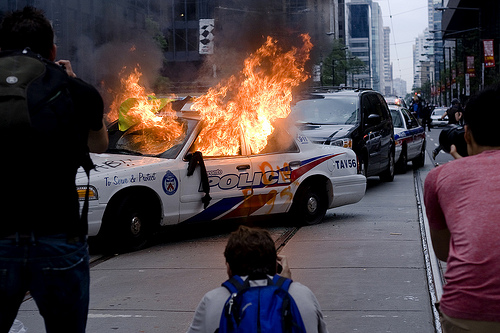Sunday June 27, Canada woke up to saturation media coverage of police trying to reassert themselves as the dominant force in protest-ravaged Toronto. Attention focused on the downtown core, where reports were coming in the morning of overnight raids at the University of Toronto and at the Novotel Hotel on the Esplanade. The geography of our city was being rewritten before our eyes on all news channels in a manner reminiscent of the breathless coverage of far-away wars.
And Sunday, June 27 — as we all know — ended with one of the most outrageous exploits of the police in which hundreds of people were “kettled” for hours on Queen Street. It’s the psychogeography of Queen Street that makes the events there so very interesting — Queen Street is an iconic Toronto thru-way that in the stretch between Yonge and Spadina separates the ritzy financial district from our more mixed Chinatown. During the People First march on June 26, it was in the short city blocks between John and Spadina on Queen that police clashed with protesters.
After demonstrators walked down University Avenue to Queen, the police lines on streets running south became more menacing: at every intersection — Simcoe, Duncan, John and Peter — police in riot gear were visible. People who wanted to see what was going on went up to the police lines only to be met with raised shields. In moments, there were a couple of scuffles going on and even those trying to back away were met with swinging batons. And of course, it’s not news now that Queen and Spadina was where thousands of people surged south — mostly, it has to be said — because they could. Many more thousands, of course, kept going north.
But over the next couple of hours, as a couple of thousand people milled around on the street between Queen and Peter and Richmond and Spadina — and were filmed doing so — it became obvious that this was a moment out of time. After the rest of the march tailed away north, what police there were retreated and left the street to those wanted to be there. People sat around, eating street meat and drinking coffee from Lettieri, and once the phalanx of black clad miscreants had run east on Queen, those who were peacefully claiming their right to be at that intersection stood around and visited. Anarchy it wasn’t.
The same police force that boxed in hundreds of peaceful protestors in a number of other locations later seems to have been utterly unable to manage the situation on Queen on Saturday afternoon. The caveat here is that outside of the Black Bloc on its way east to Yonge, the protestors on Queen — even those who broke from the official march route — were in no way destructive. Their presence there was a symbolic intervention in the state’s dictation of where the march goes; it had much the same air of “you can’t tell me where to go” as did most protestors’ disdain for the “free speech zone” in Queen’s Park (and there’s another story there about the police charging those who did gather there). This was no riot.
The Black Bloc running along Queen has been captured on numerous videos. None of the thousands of police in the city bothered to intervene — in fact, reports are now emerging that the police were told to “not engage” with those running amok. It’s interesting to note in this context that Crown Prosecutor Meghan Scott is on the record saying that undercover police were on the ground there photographing the scene on Queen where police cars were burnt. So of course was mainstream media, who made sure that the endless loop of squad cars burning played and played over again all over Canada on Saturday evening and night.
Cue the incredible police crackdown later that night and all day Sunday, especially on the same stretch of Queen immortalized in the loops of burning police cars and chanting demonstrators. It is no coincidence then the worst of the exercises of boxing in peaceful protesters — and random shoppers — was just over 24 hours later, in the same section of Queen Street, between Peter and Spadina. This story has been told too many times for it to be need to be re-told. But the geography has been overlooked.
Having so spectacularly failed to protect that intersection on Saturday afternoon — having fled the scene (for whatever reason) and left behind marked police cars — those in charge of law and order in the city during the G20 set up that intersection as the visual marker of the breakdown of law and order. And then had to conclude that narrative with an equally charged spectacle of the riot squad taking back Queen and Spadina, in full sight of mainstream media. The spectacular images that were played over and over again, on every TV channel, were of the burning police car in the first instance and of underdressed and drenched folks surrounded by heavily clad riot police in the other. Anyone who knows Toronto well will recognize the iconic Steve’s music sign in the background; just as identifiable is the sign for Metropolis Records and for Lettieri in the other. The police retaking control of that intersection had to be an equally stunning visual spectacle in order to compete with the visual of burning police cars; and by stacking the might of the state’s most heavily armed police against a crowd clad in summerwear, they managed that.
But the disturbing images do beg the question: where would you choose to be? Which of these scenes is the one in which you would feel safer as a by-stander? In the “anarchy” of the crowd milling around on Saturday afternoon or under the watchful gaze of the men in navy clashing their batons against their shields on Sunday night?



